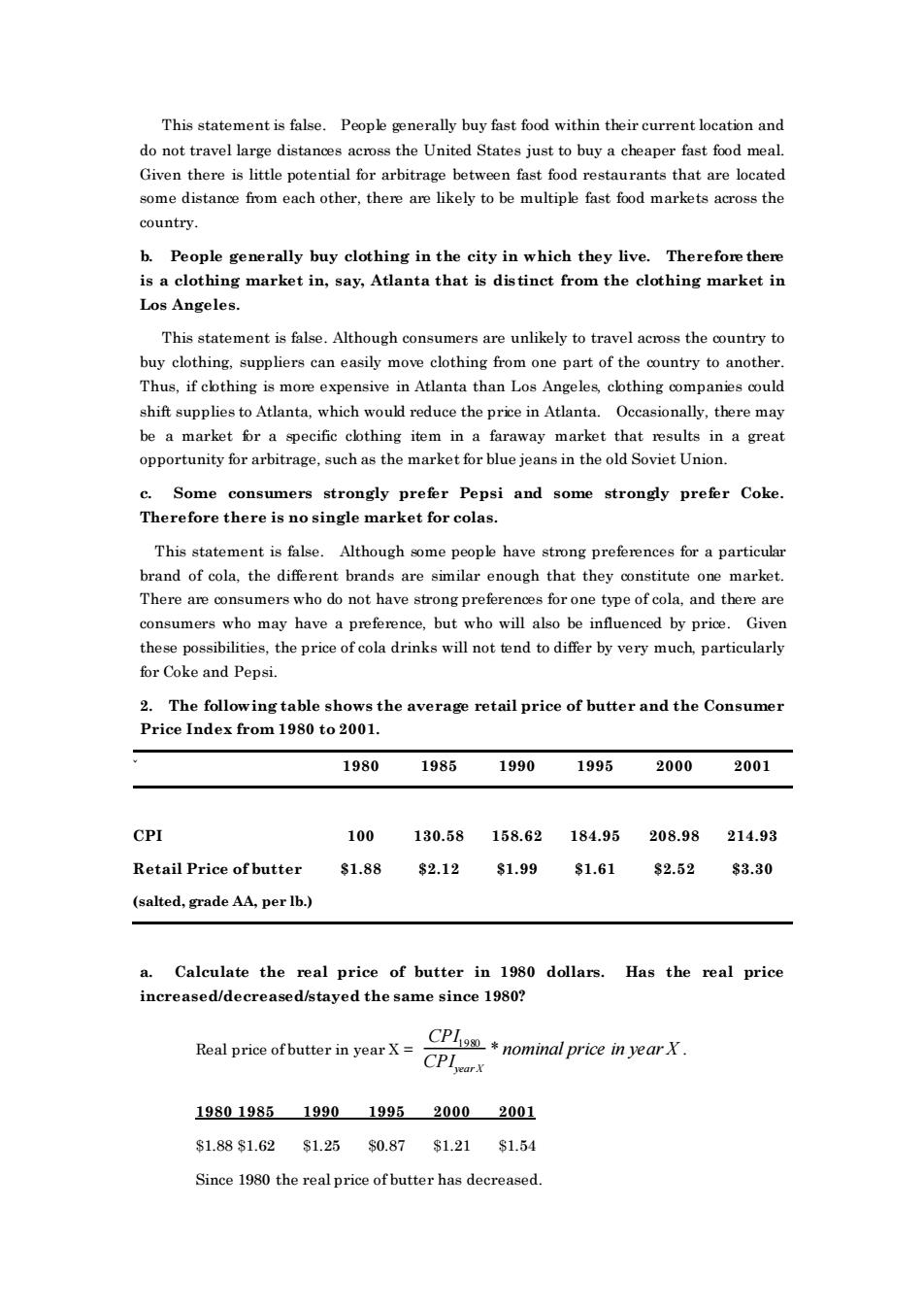正在加载图片...

This statement is false.People generally buy fast food within their current location and do not travel large the United Statesjust to buyacheaper fast food meal. Given there is little potential for arbitrage between fast food restaurants that are locat some distance from each other,there are likely to be multiple fast food markets across the country. b.People generally buy clothing in the city in which they live.Therefore there is a clothing market in,say,Atlanta that is distinct from the clothing market in Los Angeles. This statement is fals.Although unlikely to travelac the Thus,if cbthing is more expensive in Atlanta than Los Angeles,clothing companies could shift supplies to Atlanta,which would reduce the price in Atlanta.Occasionally,there may be a market for a specific clthing item in a faraway market that results in a great opportunity for arbitrage,such as the market for blue jeans in the old Soviet Union. Some rs strongly】 orefer Pepsi and some strongly prefer Coke Therefore there is no single market for colas This statement is false.Although some people have strong preferences for a particula brand of cola.the different brands are similar enough that they constitute one market. There are consumers who do not have strong preferences for one type of cola,and there are consumers who may have a preference,but who will also be influenced by price.Given these possibilities,the price of cola drinks will not tend to differ by very much,particularly for Coke and Pepsi. 2.The hows theavera retail price of butera the Price Index from 1980 to2001. 198019851990199520002001 CPI 100130.58158.62184.95208.98214.93 Retail Price of butter $1.88 $2.12 $1.99 $1.61 $2.52 $3.30 (salted,grade AA.per lb.) a.Calculate the real price of butter in 1980 dollars. Has the real price increased/decreased/stayed the same since 1980? Real price ofbutter in yearX= CPlycorx 198019851990199520002001 $1.88$1.62$1.25$0.87$1.21$1.54 Since 1980 the real price of butter has decreased This statement is false. People generally buy fast food within their current location and do not travel large distances across the United States just to buy a cheaper fast food meal. Given there is little potential for arbitrage between fast food restaurants that are located some distance from each other, there are likely to be multiple fast food markets across the country. b. People generally buy clothing in the city in which they live. Therefore there is a clothing market in, say, Atlanta that is distinct from the clothing market in Los Angeles. This statement is false. Although consumers are unlikely to travel across the country to buy clothing, suppliers can easily move clothing from one part of the country to another. Thus, if clothing is more expensive in Atlanta than Los Angeles, clothing companies could shift supplies to Atlanta, which would reduce the price in Atlanta. Occasionally, there may be a market for a specific clothing item in a faraway market that results in a great opportunity for arbitrage, such as the market for blue jeans in the old Soviet Union. c. Some consumers strongly prefer Pepsi and some strongly prefer Coke. Therefore there is no single market for colas. This statement is false. Although some people have strong preferences for a particular brand of cola, the different brands are similar enough that they constitute one market. There are consumers who do not have strong preferences for one type of cola, and there are consumers who may have a preference, but who will also be influenced by price. Given these possibilities, the price of cola drinks will not tend to differ by very much, particularly for Coke and Pepsi. 2. The following table shows the average retail price of butter and the Consumer Price Index from 1980 to 2001. ˇ 1980 1985 1990 1995 2000 2001 CPI 100 130.58 158.62 184.95 208.98 214.93 Retail Price of butter $1.88 $2.12 $1.99 $1.61 $2.52 $3.30 (salted, grade AA, per lb.) a. Calculate the real price of butter in 1980 dollars. Has the real price increased/decreased/stayed the same since 1980? Real price of butter in year X = CPI1980 CPIyear X * nominal price in year X . 1980 1985 1990 1995 2000 2001 $1.88 $1.62 $1.25 $0.87 $1.21 $1.54 Since 1980 the real price of butter has decreased